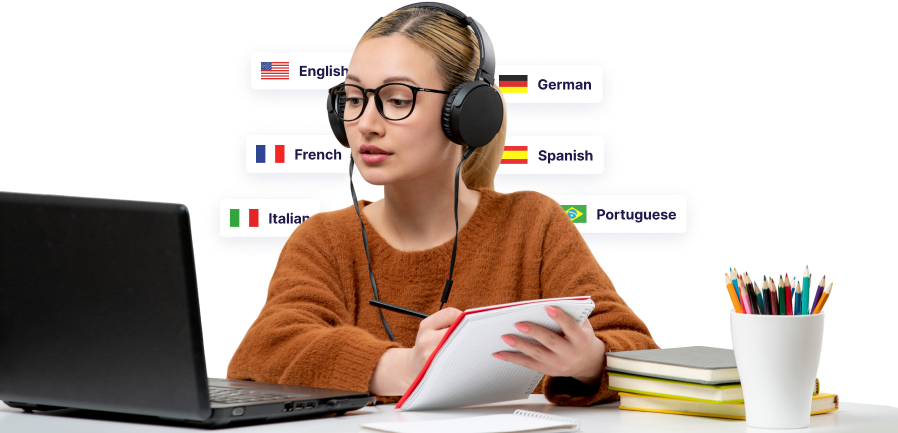ラピッド・トランスレート・チーム
電子商取引は、ビジネスがグローバルに展開するための強力なツールであることが証明された。しかし、この拡大を制限する要因の1つに、文化や国間の言語のギャップがあります。幸いなことに、eコマース翻訳は、異なる言語を話す人々がオンラインコンテンツを利用できるようにします。
これにより、さまざまなユーザーがニーズに合った製品やサービスを見つけられるようになります。このブログ記事では、eコマースにおける翻訳の役割について説明します。また、ユーザーエクスペリエンス(UX)を向上させるためにこのサービスを使用するための戦略とベストプラクティスについても説明します。
Eコマースコンテンツの翻訳について詳しく理解するには、最後までお読みください!

目次
Eコマース翻訳とは?
Eコマース翻訳とは、Eコマースウェブサイト上のすべてのコンテンツを別の言語に変更するプロセスです。これには、ユーザーレビュー、商品説明、支払い方法、ナビゲーションメニューなどが含まれます。これにより、異なる言語を話すユーザーがウェブサイトとそのコンテンツに簡単にアクセスし、楽しむことができるようになります。
eコマースコンテンツの翻訳は、企業が国際市場に進出する上で非常に重要です。この作業は、世界中の顧客にスムーズなオンラインショッピング体験を提供するのに役立ちます。高品質のウェブサイト翻訳は、エンゲージメント、信頼性、国際的な売上を高める効果的な方法です。
しかし、この種の翻訳は、テキストをある言語から別の言語に変更するだけではありません。ターゲット市場の文化的嗜好や違い、システムに合わせてコンテンツを適合させることです。言語業界では、ユーザーエクスペリエンスを向上させるためにローカライズされたコンテンツを提供することを意味します。

電子商取引における翻訳の主な構成要素
さまざまなeコマースサイトは基本的なものに見えますが、いくつかの要素が組み合わさってそうなっています。これらの要素は、グローバルビジネスにおける文書翻訳の主要な構成要素です。これらの要素は、さまざまな場所でのユーザー体験を高めるのに役立ちます。これらの要素には以下が含まれます:
- 商品説明:さまざまな商品の説明を翻訳することは、潜在的な購入者に情報を提供するために不可欠です。これらの説明をターゲット言語に合わせることで、顧客にとって文化的に適切なコンテンツになります。また、その商品をその地域の市場に最適なものにするための特定の用語を使用します。
- ユーザーインターフェースの特徴:翻訳されたeコマースサイトは、異なる言語に適した機能を備えていなければなりません。これには、翻訳されたメニュー、ボタンテキスト、ナビゲーションオプションが含まれます。この部分は、言語に関係なく、すべての要素が適切なスペースに収まることが必要です。
- 法令遵守:これは、ローカライズされたコンテンツが現地市場の法的基準、プライバシーポリシー、利用規約を満たしていることを保証します。正確な翻訳は、すべての人が法的基準を遵守するために非常に重要です。
- 技術的要素:サイズ、記号、重さ、単位、通貨を現地のシステムに合わせる。
- 文化的要素:この部分には、対象文化に当てはまらないかもしれない内容、ルール、信念を変えることが含まれる。
- マーケティングおよびSEOコンテンツ:これは、ブログ記事、広告資料、製品プロモーションの翻訳を含みます。また、ターゲット言語の検索エンジン向けにサイトを改善するためのキーワードやタグの変更も含まれます。この部分には、より良い可視性とリーチを確保するために、さまざまな言語でのキーワード調査が含まれます。
- 顧客サポート:翻訳には、多言語での顧客サービスも含まれる。これは、さまざまな場所で顧客満足度を高めるために役立ちます。さらに、FAQ、サポート文書、チャットボットの翻訳もあります。

Eコマース翻訳サービスを利用するための7つの戦略
グローバル市場に効果的に影響を与えるためには、いくつかの戦略を適用する必要があります。これらの戦略は、eコマース翻訳サービスの利用方法など、ビジネスのさまざまな側面に適用されます。
このセクションでは、これら7つの戦略を紹介する。
1.ターゲット市場を理解する
ターゲット市場を調査し、消費者の行動、好みの商品、オンラインショッピングの習慣、好みの支払い方法などを理解する。これらの情報をすべて把握したら、彼らのニーズや好みに合わせてコンテンツを変更しましょう。
このコンテンツはまた、その地域の価値観、習慣、伝統に沿ったものでなければならない。これは、メッセージが市場の消費者にとって自然に感じられるようにするための完璧な方法である。
2.インパクトのあるコンテンツに集中する
トップマーケティング資料、商品説明、カスタマーサポートページなど、最も重要なページから翻訳を始めましょう。また、定期的に変更されるコンテンツを正確かつ迅速に翻訳するための計画を立てましょう。
3.機械翻訳と人間の努力を組み合わせる
機械翻訳ツールと人間によるレビューを組み合わせることで、生産性と精度のバランスをとることができます。翻訳ツールを使用して大量のコンテンツを翻訳し、人間の翻訳サービスを使用して編集します。
翻訳管理システムを使用すると、以前に翻訳したコンテンツを保存し、一貫した結果を得ることができます。Smartling、Lokalise、およびPhraseのようないくつかのトップクラスのシステムは、eコマースに対応しています。
4.ローカルSEOの実践
ターゲット市場の検索行動に合わせてキーワードを翻訳し、ローカライズする。これには、メタディスクリプション、タグ、その他のSEO要素も含まれます。検索エンジンのランキングを向上させるために、オーディエンスのニーズや興味を満たすコンテンツを作成する。
5.地元の専門家と協力する
現地の専門家と提携し、翻訳を見直し、現地の基準や法的基準を満たしていることを確認する。現地のインフルエンサーと協力し、市場に関する知識を得る。
6.成長計画
コンテンツの更新や拡張が簡単にできるように設計しましょう。これは、プロモーションや商品リストが頻繁に変更されるサイトでは特に重要です。ブランドの拡大に合わせて、新しい市場や言語をスムーズに追加できるような戦略を立てましょう。
7.多言語によるカスタマーサポートの提供
ユーザーエクスペリエンスを向上させるために、様々な言語でカスタマーサポートを提供する。これは、電子メールサポート、ライブチャット、電話サポートなどの領域をカバーしています。また、よくある質問やその地域の習慣について、カスタマーサポートチームをトレーニングする。

Eコマースコンテンツ翻訳のベストプラクティス
翻訳の品質を維持するためのベストプラクティスを見てみましょう:
- 翻訳サービス プロフェッショナル翻訳サービス:eコマースに精通したプロの翻訳者のサービスを利用することで、正確な翻訳が可能になります。さらに、市場のトレンドや現地の言語、文化の違いについても熟知していることを確認しましょう。
- ローカライズされたアプローチを使用します: ローカライズ翻訳を使用して、地域市場に適したコンテンツを調整しましょう。これには、画像、支払いオプション、単位や寸法、スローガン、配送ポリシー、SEOコンテンツなどが含まれます。
- 一貫したブランディングを維持する:ブランドは、すべての言語において常に一貫したボイス、メッセージ、トーンであるべきです。これには、モバイルアプリ、ウェブサイト、ソーシャルプラットフォーム、その他のリソースにおける一貫した翻訳も含まれます。
- 定期的なテスト:定期的にコンテンツをテストし、各市場の好みを見極めましょう。顧客からのフィードバックを収集・分析し、翻訳コンテンツや戦略を調整しましょう。
- ローカルルールに従う:プライバシーポリシー、利用規約、返品規定などの法的文書を翻訳する。これにより、貴社のeコマースサイトが現地の法律や消費者の権利を遵守していることが保証されます。
- コンテンツを定期的に更新する:消費者の嗜好に合ったコンテンツになるよう、翻訳コンテンツを見直し、更新する。
- マーケティングキャンペーンの調整言語や文化的特質に基づいて、地域のオーディエンスに適したマーケティング翻訳を作成しましょう。また、異なる地域のユーザー向けにソーシャルメディアコンテンツを翻訳し、適応させる必要があります。
FAQ
さて、ここまでeコマースにおける翻訳の活用方法について解説してきましたが、次によくある質問にお答えしましょう!
eコマース翻訳とは?
eコマースの翻訳では、オンライン販売のコンテンツをある言語から別の言語に変換します。このプロセスにより、貴社のメッセージがターゲット市場のネイティブスピーカーにとって文化的に適切であることが保証されます。
eコマース・ウェブサイト全体をローカライズすべきか、それとも特定のページだけをローカライズすべきか?
このアクションは、あなたのリソースとターゲット市場に依存します。とはいえ、完全なユーザー体験のためには、ウェブサイト全体をローカライズするのがベストです。しかし、リソースが限られている場合は、インパクトの強い部分から始めることができます。これらの領域は、あなたの国際的な顧客を引き付ける可能性が高くなります。
電子商取引において、翻訳はどのように行われるのか?
eコマースにおける翻訳は、コンテンツをターゲット顧客の母国語に変更する組織的なプロセスを通じて行われます。そのプロセスには、コンテンツの特定と抽出、翻訳とローカライズ、そしてレビューが含まれます。
この後、次のステップは、コンテンツを使用し、統合し、定期的に更新し、維持することである。これらはすべて、対象市場の法的、文化的、技術的な特質に注意を払いながら行われる。
プロのEコマース翻訳会社が必要ですか?Rapid Translateにお任せください
Eコマースコンテンツを翻訳し、ローカライズすることは、あなたのブランドが世界中のオーディエンスにリーチするために役立ちます。しかし、プロのeコマース翻訳会社のサービスなしには、これを達成することは不可能です。翻訳会社は、お客様の業界の言語専門家のサービスを利用し、高品質の結果を提供します。
Rapid Translateは、ソース言語からコンテンツを翻訳するだけでなく、ターゲットとする読者にとって文化的に適切な翻訳を行います。当社は、まさにこのような質の高いサービスを世界中のビジネスに提供しています。当社のサービスは、国際的な販売を促進するさまざまなビジネス資料をカバーしています。
さらに、お客様のコンテンツをローカライズすることで、ターゲット顧客のロイヤリティと信頼を高めます。最高のeコマース翻訳ソリューションが必要な場合は、Rapid Translateを最初の選択肢にしてください。





